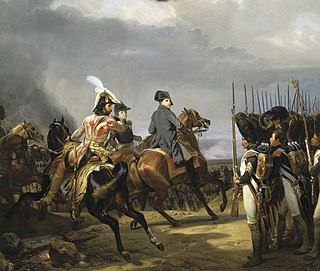French army

General de Division Jean-Baptiste Jourdan (75,000)
- Reserve artillery
- Two foot artillery companies
Army of the Moselle
GdD Jean-Baptiste Jourdan
- GdD Jacques Maurice Hatry (11,000)
- GdB Jean-Antoine Chapsal
- 27th Line Infantry Regiment, 1st Battalion
- 44th Line Infantry Regiment, 1st Battalion
- Moselle National Guard, 2nd and 3rd battalions
- Côte-d'Or National Guard, 3rd Battalion
- Seine-et-Oise National Guard, 6th Battalion
- Doubs National Guard, 9th Battalion
- 11th Dragoon Regiment, three squadrons
- 18th Chasseurs à Cheval, one squadron
- GdB Jean Pierre François Bonet
- 33rd Line Infantry Regiment, 2nd Battalion
- 58th Line Infantry Regiment, 2nd Battalion
- Lot-et-Garonne National Guard, 1st Battalion
- Loiret National Guard, 2nd Battalion
- Var National Guard, 4th Battalion
- One foot artillery company
- GdB Jean-Antoine Chapsal
- GdD Antoine Morlot (8,600)
- GdB Jean-Baptiste Olivier
- 110th Line Infantry Regiment, three battalions
- 14th Dragoon Regiment, three squadrons
- GdB Henri Simon
- 1st Line Infantry Regiment, three battalions
- 34th Line Infantry Regiment, three battalions
- 10th Cavalry Regiment, four squadrons
- One foot artillery company
- GdB Jean-Baptiste Olivier
- GdD Jean Étienne Championnet (9,100)
- GdB Paul Grenier
- 18th Line Infantry Regiment, three battalions
- 1st Dragoon Regiment, three squadrons
- GdB Claude Juste Alexandre Legrand
- 59th Line Infantry Regiment, three battalions
- 94th Line Infantry Regiment, three battalions
- 4th Cavalry Regiment, three squadrons
- One foot artillery company
- GdB Paul Grenier
- GdD François Joseph Lefebvre (8,800)
- GdB Jean François Leval
- 5th Line Infantry Regiment, 1st Battalion
- 54th Line Infantry Regiment, 2nd Battalion
- 99th Line Infantry Regiment, 2nd Battalion
- 9th Foot Chasseurs Battalion
- GdB Jean-Baptiste Jacopin
- 13th Line Infantry Regiment, three battalions
- 80th Line Infantry Regiment, three battalions
- 149th Line Infantry Regiment, three battalions
- GdB Jean Sultzmann
- 16th Light Infantry Battalion
- 1st Foot Chasseurs Battalion
- 18th Foot Chasseurs Battalion
- Legion of the Moselle
- One foot artillery company
- GdB Jean François Leval
Army of the North
- GdB Guillaume Philibert Duhesme (10,000)
- GdB Jean Schlachter
- Saint-Denis National Guard, 1st Battalion
- Vosges National Guard, 5th Battalion
- 4th Hussar Regiment, four squadrons
- 12th Chasseurs à Cheval Regiment, five squadrons
- GdB Louis Fuzier
- 47th Line Infantry Demi-brigade, three battalions
- Vienne National Guard, 2nd Battalion
- Paris National Guard, 10th Battalion
- Seine-et-Oise National Guard, 10th Battalion
- GdB Jean-Baptiste Bernadotte
- 56th Line Infantry Demi-brigade, three battalions
- 32nd Light Infantry Battalion
- Orne National Guard, 1st Battalion
- Meurthe National Guard, 2nd Battalion
- 22nd Cavalry Regiment, four squadrons
- One foot artillery company
- GdB Jean Schlachter
- GdD Anne Charles Basset Montaigu (8,200)
- GdB Joseph Léonard Richard
- 10th Light Infantry Battalion
- 4th Foot Chasseur Battalion
- 6th Cavalry Regiment, one squadron
- 7th Dragoon Regiment, four squadrons
- 16th Chasseurs à Cheval Regiment, one squadron
- GdB André Poncet
- 18th Line Infantry Demi-brigade, 1st Battalion
- 49th Line Infantry Demi-brigade, 1st Battalion
- 68th Line Infantry Demi-brigade, 1st and 2nd Battalions
- 89th Line Infantry Demi-brigade, 1st Battalion
- GdB Joseph Boisset
- Calvados National Guard, 2nd Battalion
- Haut-Rhine National Guard, 2nd and 3rd battalions
- Mayenne-et-Loire National Guard, 2nd Battalion
- Nièvre National Guard, 2nd Battalion
- Eure National Guard, 3rd Battalion
- Somme National Guard, 5th Battalion
- Oise National Guard, 6th Battalion
- Two foot artillery companies
- GdB Joseph Léonard Richard
- Detached from GdD Marie-Louis Ferrand
- GdB Charles Daurier (6,000)
- 18th Line Infantry Demi-brigade, 2nd Battalion
- 72nd Line Infantry Demi-brigade, 1st and 2nd battalions
- Loiret National Guard, 1st Battalion
- 17th Cavalry Regiment, four squadrons
- One foot artillery company
- GdB Charles Daurier (6,000)
- Cavalry Division: Paul-Alexis Dubois (2,300)
- GdB Jean-Joseph Ange d'Hautpoul
- 12th Dragoon Regiment, four squadrons
- 2nd Hussar Regiment, two squadrons
- 6th Chasseurs à Cheval Regiment, four squadrons
- One horse artillery company
- GdB Guillaume Soland
- 6th Cavalry Regiments, four squadrons
- 8th Cavalry Regiments, four squadrons
- One horse artillery company
- GdB Jean-Joseph Ange d'Hautpoul
Army of the Ardennes
GdD François Séverin Marceau-Desgraviers
- GdD Marceau (6,000)
- GdB Jean Thomas Guillaume Lorge
- 9th Line Infantry Regiment, three battalions
- 172nd Line Infantry Regiment, three battalions
- Nord National Guard, 3rd Battalion
- Pas-de-Calais National Guard, 8th Battalion
- GdB Jean Hardy
- Vendee National Guard, 1st Battalion
- Volunteers National Guard, 2nd Battalion
- 11th Chasseurs à Cheval, four squadrons
- One foot artillery company
- GdB Jean Thomas Guillaume Lorge
- GdD Jean Adam Mayer (5,500)
- GdB Jean Charles Prestat
- 26th Line Infantry Regiment, three battalions
- Nord National Guard, 2nd Battalion
- Seine-Inférieur National Guard, 7th Battalion
- GdB Claude Lecourbe
- 16th Light Infantry Battalion
- Aisne National Guard, 4th Battalion
- 20th Chasseurs à Cheval, two squadrons
- One foot artillery company
- GdB Jean Charles Prestat








